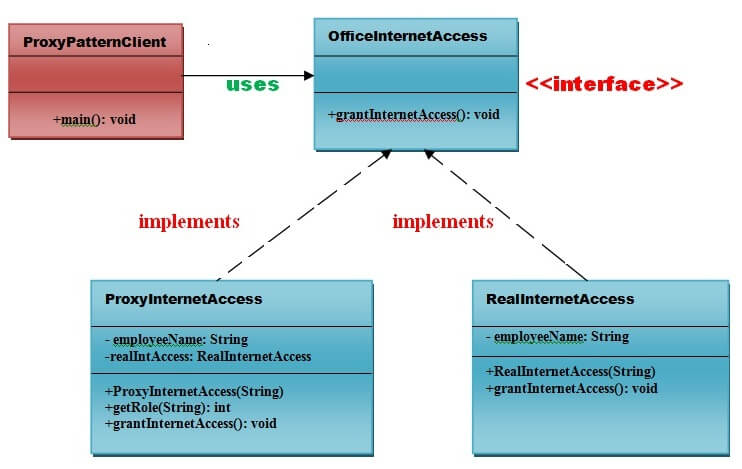Proxy Design Pattern in C# With Examples
Table Of Content

It is only when the client calls generateComplexReport() that we wrote from Line 16 to Line 21, we create a ReportGeneratorImpl object and pass the method call to it. From Line 22 to Line 33, we wrote the generateSesnsitiveReport() method to implement the functionality of a protection proxy. In this method, we checked the role name of aRole object that the proxy was initialized with.
Preview – AWS Migration Hub Refactor Spaces Helps to Incrementally Refactor Your Applications Amazon Web ... - AWS Blog
Preview – AWS Migration Hub Refactor Spaces Helps to Incrementally Refactor Your Applications Amazon Web ....
Posted: Mon, 29 Nov 2021 08:00:00 GMT [source]
Proxy Pattern C++ Design Patterns

On the other hand, if the employee is a developer, it should not allow access to the shared folder. In proxy pattern, a class represents functionality of another class. The Proxy Pattern allows you to control access to a resource (in this case, an image) and manage when and how the real object is created and accessed without changing the client’s code. This object will call the concrete image viewer only when needed, i.e. when the client calls the displayImage() method.
Subject
And when coupled with dependency injection in Spring, you could easily run all locally for development tasks, while using a remoting proxy once deployed to the production environment. In this example, the Proxy pattern helps to implement the lazy initialization and caching to an inefficient 3rd-party YouTube integration library. Having proxies act as wrappers around such resources is a great way of implementing customized access control.
Advantages of the Proxy Method Design Pattern in Java
What this Folder proxy can do is it will check if the employee’s role is Manager or CEO, and then it allows the employee to access the shared folder and perform the read-write operation. On the other hand, if the employee role is Developer, it will say you don’t have permission to access this folder. We use that kind of protection logic we can write using the Proxy Design Pattern. Within the Folder Proxy, we must write the logic to filter the incoming requests. Proxy Pattern is a structural design pattern that lets you provide a substitute or placeholder for another object. A proxy controls access to the original object, allowing you to perform something either before and after the request gets through to the original object.
Proxy Method Design Pattern in Java
But in enterprise applications, objects of RealSubject classes, such as our ReportGeneratorImpl will be resource-intensive, and we should be interested in creating their proxies. Imagine that the generateComplexReport() method needs to communicate with remote repositories and services to perform data mining to discover patterns from large data sets. For that, we perform all the initialization and setup tasks in the constructor. Also, the generateSensitiveReport() method has to follow regulatory requirements and security policies and so needs to be protected from unauthorized access. The Proxy pattern uses a proxy (surrogate) object “in place of” another object.
For example, to check the access rights of clients accessing a sensitive object. The Proxy Design Pattern allows us to create a class that represents the functionality of other classes. The proxy could interface with anything, such as a network connection, a large object in memory, a file, or other resources that are expensive or impossible to duplicate. It’s only when a user clicks on the Generate Report button on the UI we will need to instantiate the report generator object and ask it to create the report.
Implementation
The proxy is a ReportGeneratorImplProxy class that clients interact with. The ReportGeneratorImplProxy class also implements the ReportGenerator interface. Some objects or resources might need appropriate authorization for accessing them, so using a proxy is one of the ways in which such conditions can be checked. With protection proxies, we also get the flexibility of having many variations of access control. This makes it possible to work through a Proxy object to perform additional functionality when accessing a subject.
How Unnecessary Complexity Gave the Service Mesh a Bad Name - InfoQ.com
How Unnecessary Complexity Gave the Service Mesh a Bad Name.
Posted: Tue, 28 Sep 2021 07:00:00 GMT [source]
The methods on the Reflect object have the same name as the methods on the handler object. When trying to modify a property, thus invoking the set method on the Proxy, we want the proxy to log the previous value and the new value of the property. When trying to access a property, thus invoking the get method on the Proxy, we want the proxy to log a more readable sentence that contains the key and value of the property. The proxy can implement caching for recurring requests that always yield the same results. This is when you need to cache results of client requests and manage the life cycle of this cache, especially if results are quite large.
We’ll create a simplified example where an Image class is used to represent images, and we’ll implement a proxy to control access and display these images. The Proxy Design Pattern is a clever way of using some costly resources or providing certain access rights. It is structurally similar to the Adapter and Decorator patterns, although with a different purpose. Each proxy is realized in such a way that it offers exactly the same interface to the client as a real object. This means that the client effectively notices no difference while using the proxy object.

It allows you to add an additional layer of functionality to your classes without altering their structure. By using proxies, you can achieve lazy initialization, access control, logging and caching, improving the performance and maintainability of your code. When applied appropriately, the Proxy Pattern can be a powerful asses in your design patterns toolbox. In the proxy class above, we implemented the same ReportGenerator interface of ReportGeneratorImpl.
Remote Proxies provide a local representation of another remote object or resource. Remote proxies are responsible not just for representation but also for some maintenance work. Such work could include connecting to a remote machine and maintaining the connection, encoding and decoding characters obtained through networking traffic, parsing, etc. Proxy is heavily used to implement lazy loading related usecases where we do not want to create full object until it is actually needed. Software development practices entail a myriad of challenges, one of which is the efficient management of resources.
A proxy can also be useful if we'd like to limit the access or functionality of an object. The primary difference between both patterns are responsibilities they bear. Decorators focus on adding responsibilities, but proxies focus on controlling the access to an object. The Proxy Design Pattern serves as a powerful tool in a developer’s toolkit, providing an efficient mechanism for controlled and simplified access to objects. It elegantly separates the responsibilities of object usage and object management, enabling higher code maintainability, security, and effective resource management. And last but not least, the multiprocessing module in Python includes the Pool class, which provides a high-level interface for distributing tasks across multiple processes.
Loading images from disk or other external sources can be resource-intensive, especially if the images are large or stored remotely. Create a class file named Employee.cs and copy and paste the following code. As you can see, this is a very simple class having three properties, i.e., Username, Password, and Role, and we also have one Parameterized constructor to initialize these data members.
The lru_cache decorator acts as a proxy by intercepting function calls, caching the results, and returning the cached result for subsequent calls with the same arguments. It simplifies access to the underlying expensive computation and enhances performance. Design Patterns can be combined effectively with other design patterns for more optimized solutions.

Comments
Post a Comment